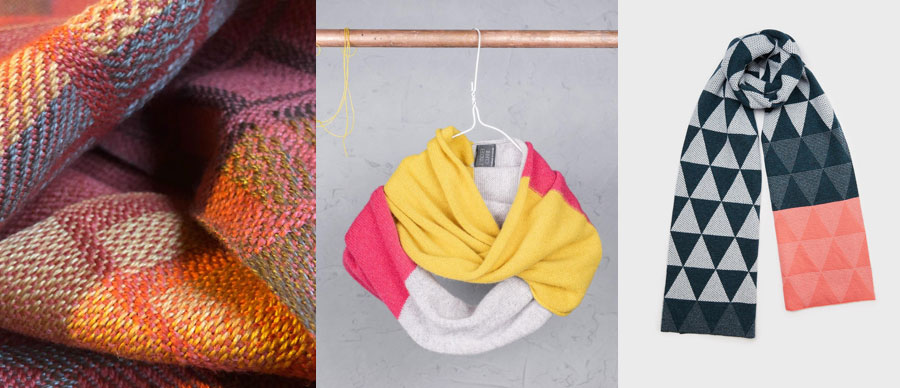

Wool is a versatile, hardwearing and functional textile, used for a variety of uses from interior textiles to wearable garments. Although wool is in no way unique to Scotland, it has been produced here for many centuries and has played a significant role in our history. It’s used for its warmth and longevity, and is overall a sustainable and renewable material.
The characteristics of wool vary depending on the breed of sheep and where they are farmed, and can range from silky soft, to coarse and heavy. Some common characteristics across varieties are it’s elasticity, it’s hygroscopic nature (in other words, it absorbs and releases moisture in the environment meaning it is breathable and helps regulate temperature), and is a flame-retardant fibre.
It is estimated that there are just under 7 million sheep in Scotland, which is bigger than the country’s human population! Around 9% of these sheep (621,000 in 2015) are located in the Tayside region. The vast majority of these sheep are used for the production of meat rather than wool, and as wool is often a by-product of the meat industry, it is difficult to find figures for how many wool producing sheep there are, but just under 6000 tonnes of wool were produced in Scotland in 2015.
The wool produced by sheep varies depending on lots of different factors, including the breed and the habitat where it is produced. Many of the sheep in Scotland produce wool which is coarse and thick, making it ideal for making products used in interiors as well as making coarse, hard wearing tweeds.
Wool is a very versatile material and is used in a wide variety of settings. It is widely used in fashion to create knitted and woven garments such as scarves, hats, jumpers, and coats. It’s also commonly used to create interior textiles including carpets, upholstery fabrics, and homewares like cushions and blankets. And it can even be used as insulation for buildings!
There are a number of well established heritage factories within Scotland who produce woven and knitted woollen textiles such as Johnstons of Elgin and Harris Tweed, as well as many contemporary Designer/Makers who are based in, or have studied in, Dundee including Cally Booker (Bonny Claith – weaver), Lyndsey Currie (knitwear), and Hilary Grant (knitwear).

Wool is produced from the fleece of sheep (as well as other animals with fleecy coats including alpacas and goats) and is made of keratin, like human hair. Sheep grow a new fleece on a yearly basis, which is removed from the sheep by shearing. Although this doesn’t harm the sheep (or shouldn’t if done correctly) there are still significant animal welfare concerns to be taken into consideration which are enforced by law in Scotland and across the rest of the UK. Sheep’s fleece are required to be shorn on a yearly basis for the comfort and health of the animal, and British Wool offer intensive training courses for sheep farmers across the UK to help ensure that wool is produced in line with their best practise guidelines to ensure the health and safety of the animal, as well as maximising the value of the wool.
Once the wool has been shorn from the sheep, it goes through a series of steps to transform it from raw fleece to workable wool. This includes scouring (cleaning), carding (combing), spinning, and dying. After the wool has been spun, it can then be made into fabrics by weaving or knitting.
Wool has a lot of positives and is, on the whole, a very sustainable material. It can be recycled, it’s biodegradable, renewable, and can be produced organically. It is also naturally resistant to stains and odours which reduces the amount of cleaning and laundering required, and it doesn’t shed microplastics that contribute to water pollution like synthetic textiles do.
On the other hand, sheep do contribute to rising levels of methane in the atmosphere, and processing and dyeing can use large volumes of water and some chemicals used in the washing and dyeing processes can contribute to environmental pollution. That said, these issues are not unique to the production of wool, but are widespread issues in the production of textiles in general.
“About Wool”. Campaign for Wool, https://www.campaignforwool.org/wool-facts/. Accessed 21 January 2021.
“Economic Report on Scottish Agriculture, 2016”. Scottish Government, https://www.gov.scot/publications/economic-report-scottish-agriculture-2016/pages/1/ . Accessed 21 January 2021.
“The Welfare of Farmed Animals (Scotland) Regulations 2010”. UK Legislation, https://www.legislation.gov.uk/ssi/2010/388/contents/made . Accessed 21 January 2021.
International Wool Textile Organisation. “Make A Difference – Choose Wool”. International Wool Textile Organisation, https://iwto.org/wp-content/uploads/2020/04/IWTO_Choose-Wool.pdf . Accessed 21 January 2021.
O’Daly, Bevan. “Fibre: Wool”. Bawn Textiles, https://bawntextiles.com/blogs/news/wool. Accessed 21 January 2021.
Symington, Kaye. “Wool Week: Wool what is it good for?”. Make Works, https://make.works/blog/guide-to-wool. Accessed 21 January 2021.
Symington, Kaye. “Manufacturers working in wool in Scotland”. Make Works, https://make.works/blog/wool-manufacturers. Accessed 21 January 2021.